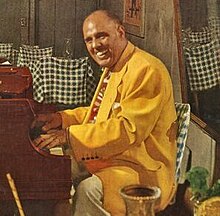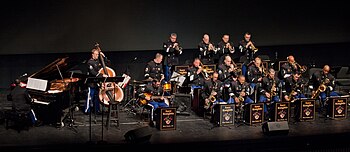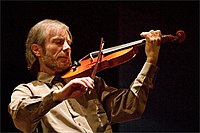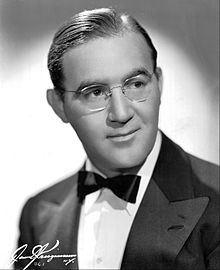Infrastructure tools to support an effective radiation oncology learning health system
Welcome to the jazz portal
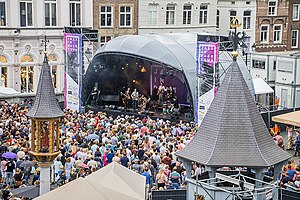
Jazz is a music genre that originated in the African-American communities of New Orleans, Louisiana, in the late 19th and early 20th centuries, with its roots in blues, ragtime, European harmony, African rhythmic rituals, spirituals, hymns, marches, vaudeville song, and dance music. Since the 1920s Jazz Age, it has been recognized as a major form of musical expression in traditional and popular music. Jazz is characterized by swing and blue notes, complex chords, call and response vocals, polyrhythms and improvisation.
As jazz spread around the world, it drew on national, regional, and local musical cultures, which gave rise to different styles. New Orleans jazz began in the early 1910s, combining earlier brass band marches, French quadrilles, biguine, ragtime and blues with collective polyphonic improvisation. However, jazz did not begin as a single musical tradition in New Orleans or elsewhere. In the 1930s, arranged dance-oriented swing big bands, Kansas City jazz (a hard-swinging, bluesy, improvisational style), and gypsy jazz (a style that emphasized musette waltzes) were the prominent styles. Bebop emerged in the 1940s, shifting jazz from danceable popular music toward a more challenging "musician's music" which was played at faster tempos and used more chord-based improvisation. Cool jazz developed near the end of the 1940s, introducing calmer, smoother sounds and long, linear melodic lines.
The mid-1950s saw the emergence of hard bop, which introduced influences from rhythm and blues, gospel, and blues to small groups and particularly to saxophone and piano. Modal jazz developed in the late 1950s, using the mode, or musical scale, as the basis of musical structure and improvisation, as did free jazz, which explored playing without regular meter, beat and formal structures. Jazz-rock fusion appeared in the late 1960s and early 1970s, combining jazz improvisation with rock music's rhythms, electric instruments, and highly amplified stage sound. In the early 1980s, a commercial form of jazz fusion called smooth jazz became successful, garnering significant radio airplay. Other styles and genres abound in the 21st century, such as Latin and Afro-Cuban jazz. (Full article...)
Selected articles -
Selected image

Related portals
Selected biographies -
Did you know (auto-generated)

- ... that Jazzy's 2023 single "Giving Me" made her the first Irish solo female act to top the Irish Singles Chart since Julie-Anne Dineen in 2009 with "Do You Believe"?
- ... that zoologist Herb Wong wrote the liner notes for more than 600 jazz albums, by his own count?
- ... that Japanese jazz cafés often require customers to be silent?
- ... that House of Waters repurposes the hammered dulcimer, an Appalachian folk music instrument, for international jazz fusion?
- ... that the lyrics to Gen Hoshino's "Crazy Crazy" references members of the jazz group Crazy Cats through kanji?
- ... that Ron Miles, who would have turned 59 today, played in the same high school jazz band as Don Cheadle?
More did you know...

- ... that Dave Brubeck's The Real Ambassadors was largely based on the goodwill tours of Louis Armstrong and other jazz musicians on behalf of the U.S. State Department during the Cold War?
- ... that for the jazz album The Meeting, Joseph Jarman returned to the Art Ensemble of Chicago after leaving in 1993 to open a Buddhist dojo in Brooklyn, New York?
- ... that for Lee Ritenour's first album, First Course, he drafted his friends, including Dave Grusin, Frank Rosolino and Tom Scott, from Dante's and the Baked Potato club in Studio City? (pictured, 2009)
June 2007
Selected recording
The West Point Band performing "The Stakeout"
Jazz by topic
Quality content
Categories
Things you can do

Create an article on a jazz-related subject
Suggest new selected articles and images for the portal here
Add new selected articles here
Add new selected biographies here
Add new selected images here
The Jazz WikiProject

The Jazz WikiProject works to improve the quality of jazz-related articles on Wikipedia. Please join us!
Associated Wikimedia
The following Wikimedia Foundation sister projects provide more on this subject:
-
 Commons
Commons
Free media repository -
 Wikibooks
Wikibooks
Free textbooks and manuals -
 Wikidata
Wikidata
Free knowledge base -
 Wikinews
Wikinews
Free-content news -
 Wikiquote
Wikiquote
Collection of quotations -
 Wikisource
Wikisource
Free-content library -
 Wikiversity
Wikiversity
Free learning tools -
 Wiktionary
Wiktionary
Dictionary and thesaurus
-

-

-

-

-
Random portal


















